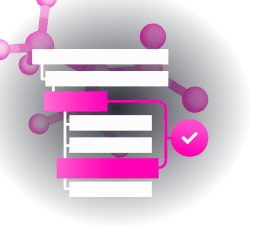Explore a selection of our essential drug information below, or:
Identification
- Summary
Repotrectinib is a tyrosine kinase inhibitor used to treat locally active or metastatic non-small cell lung cancer
- Brand Names
- Augtyro
- Generic Name
- Repotrectinib
- DrugBank Accession Number
- DB16826
- Background
Repotrectinib is a next-generation tyrosine kinase inhibitor (TKI) specifically designed to address resistance in the treatment of non-small cell lung cancer (NSCLC), specifically due to mutations in the ROS1 gene.1 ROS1 mutations are one of the defined oncogenic drives of NSCLC, and the solvent-front mutation ROS1 G2032R is responsible for 50 to 60% of crizotinib-resistant cases.1 Repotrectinib possesses a compact macrocyclic structure that both limits adverse interactions with resistance mutation hotspots and targets mutations in the solvent-front region.2 Although resistance to multiple TKI has been reported, including crizotinib, lorlatinib, taletrectinib, and entrectinib, there has been no reported case of repotrectinib resistance.3
On November 15th, 2023, the FDA approved repotrectinib under the brand name Augtyro for the treatment of locally advanced or metastatic ROS1-Positive NSCLC. This approval is based on favorable results from the TRIDENT-1 study, where the objective response rate was 79% in TKI-naive patients and 38% in TKI-pretreated patients respectively.5
- Type
- Small Molecule
- Groups
- Approved, Investigational
- Structure
- Weight
- Average: 355.373
Monoisotopic: 355.144453003 - Chemical Formula
- C18H18FN5O2
- Synonyms
- (3R,6S,)-45-FLUORO-3,6-DIMETHYL-5-OXA-2,8-DIAZA-1(5,3)-PYRAZOLO(1,5-A)PYRIMIDINA-4(1,2)-BENZENANONAPHAN-9-ONE
- (7S,13R)-11-Fluoro-7,13-Dimethyl-6,7,13,14-Tetrahydro-1,15-Ethenopyrazolo[4,3-F][1,4,8,10]Benzoxatriazacyclotridecin-4(5H)-One
- 1,15-ETHENO-1H-PYRAZOLO(4,3-F)(1,4,8,10)BENZOXATRIAZACYCLOTRIDECIN-4(5H)-ONE, 11-FLUORO-6,7,13,14-TETRAHYDRO-7,13-DIMETHYL-, (7S,13R)-
- Repotrectinib
- External IDs
- TPX-0005
Pharmacology
- Indication
Repotrectinib is indicated for the treatment of adult patients with locally advanced or metastatic ROS1-positive non-small cell lung cancer (NSCLC).4
 Reduce drug development failure ratesBuild, train, & validate machine-learning modelswith evidence-based and structured datasets.Build, train, & validate predictive machine-learning models with structured datasets.
Reduce drug development failure ratesBuild, train, & validate machine-learning modelswith evidence-based and structured datasets.Build, train, & validate predictive machine-learning models with structured datasets.- Associated Conditions
Indication Type Indication Combined Product Details Approval Level Age Group Patient Characteristics Dose Form Treatment of Locally advanced or metastatic non-small cell lung cancer •••••••••••• ••••• ••••••• - Contraindications & Blackbox Warnings
 Prevent Adverse Drug Events TodayTap into our Clinical API for life-saving information on contraindications & blackbox warnings, population restrictions, harmful risks, & more.Avoid life-threatening adverse drug events with our Clinical API
Prevent Adverse Drug Events TodayTap into our Clinical API for life-saving information on contraindications & blackbox warnings, population restrictions, harmful risks, & more.Avoid life-threatening adverse drug events with our Clinical API- Pharmacodynamics
Fusion proteins that include ROS1 domains can drive tumorigenic potential through the hyperactivation of downstream signaling pathways leading to unconstrained cell proliferation. Repotrectinib exhibited anti-tumor activity in cultured cells expressing ROS1 fusions and mutations including SDC4-ROS1, SDC4-ROS1G2032R, CD74-ROS1, CD74-ROS1G2032R, CD74-ROS1D2033N, and CD74-ROS1L2026M.4
Repotrectinib exposure-response relationships and the time course of pharmacodynamic responses are not fully characterized. Repotrectinib does not cause a mean increase in the QTc interval > 20 milliseconds (ms) at 160 mg QD followed by 160 mg BID, the approved recommended dosage.4
- Mechanism of action
Repotrectinib is an inhibitor of proto-oncogene tyrosine-protein kinase ROS1 (ROS1) and of the tropomyosin receptor tyrosine kinases (TRKs) TRKA, TRKB, and TRKC.4
Target Actions Organism AProto-oncogene tyrosine-protein kinase ROS inhibitorHumans AHigh affinity nerve growth factor receptor inhibitorHumans ABDNF/NT-3 growth factors receptor inhibitorHumans ANT-3 growth factor receptor inhibitorHumans - Absorption
The geometric mean (CV%) of repotrectinib steady state peak concentration (Cmax,ss) is 713 (32.5%) ng/mL and the area under the time concentration curve (AUC0-24h,ss) is 7210 (40.1%) ng•h/mL following the approved recommended twice daily dosage in patients with cancer. Repotrectinib Cmax and AUC0-inf increases approximately dose-proportional (but less than linear with estimated slopes of 0.78 and 0.70, respectively) over the single dose range of 40 mg to 240 mg (0.25 to 1.5 times the approved recommended dosage). Steady-state PK was time-dependent with an autoinduction of CYP3A4. Steady-state is achieved within 14 days of daily administration of 160 mg.4
The geometric mean (CV%) absolute bioavailability of repotrectinib is 45.7% (19.6%). Peak repotrectinib concentration occurred at approximately 2 to 3 hours post a single oral dose of 40 mg to 240 mg (0.25 to 1.5 times the approved recommended dosage) under fasted conditions.4
No clinically significant differences in repotrectinib pharmacokinetics were observed in patients with cancer following administration of a high-fat meal (approximately 800-1000 calories, 50% fat).4
- Volume of distribution
The geometric mean (CV%) apparent volume of distribution (Vz/F) was 432 L (55.9%) in patients with cancer following a single 160 mg oral dose of repotrectinib.4
- Protein binding
Repotrectinib binding to plasma protein was 95.4% in vitro. The blood-to-plasma ratio was 0.56 in vitro.4
- Metabolism
Repotrectinib is primarily metabolized by CYP3A4 followed by secondary glucuronidation.4
- Route of elimination
Following a single oral 160 mg dose of radiolabeled repotrectinib, 4.84% (0.56% as unchanged) was recovered in urine and 88.8% (50.6% unchanged) in feces.4
- Half-life
The repotrectinib mean terminal half-life is approximately 50.6 h for patients with cancer following a single dose. The steady-state repotrectinib terminal half-life is approximately 35.4 h for patients with cancer.4
- Clearance
The geometric mean (CV%) apparent oral clearance (CL/F) was 15.9 L/h (45.5%) in patients with cancer following a single 160 mg oral dose of repotrectinib.4
- Adverse Effects
 Improve decision support & research outcomesWith structured adverse effects data, including: blackbox warnings, adverse reactions, warning & precautions, & incidence rates. View sample adverse effects data in our new Data Library!Improve decision support & research outcomes with our structured adverse effects data.
Improve decision support & research outcomesWith structured adverse effects data, including: blackbox warnings, adverse reactions, warning & precautions, & incidence rates. View sample adverse effects data in our new Data Library!Improve decision support & research outcomes with our structured adverse effects data.- Toxicity
Based on literature reports in humans with congenital mutations leading to changes in TRK signaling, findings from animal studies, and its mechanism of action, repotrectinib can cause fetal harm when administered to a pregnant woman. There are no available data on repotrectinib use in pregnant women. Oral administration of repotrectinib to pregnant rats during the period of organogenesis resulted in fetal malformations at doses approximately 0.3 times the recommended dose of 160 mg twice daily based on BSA. Advise pregnant women of the potential risk to a fetus.4
Carcinogenicity studies with repotrectinib were not conducted. Repotrectinib was genotoxic in an in vitro assay in human lymphoblastoid TK6 cells and in an in vivo rat bone marrow micronucleus assay via an aneugenic mechanism of action. Repotrectinib was not mutagenic in vitro in the bacterial reverse mutation (Ames) assay.4
Dedicated fertility studies were not conducted with repotrectinib. There were no effects on male and female reproductive organs observed in general repeat-dose toxicology studies of up to 3 months in duration in rats and monkeys at any dose level tested, which equated to exposures of up to approximately 3 times the human exposure at the 160 mg twice daily dose based on AUC.4
- Pathways
- Not Available
- Pharmacogenomic Effects/ADRs
- Not Available
Interactions
- Drug Interactions
- This information should not be interpreted without the help of a healthcare provider. If you believe you are experiencing an interaction, contact a healthcare provider immediately. The absence of an interaction does not necessarily mean no interactions exist.
Drug Interaction Integrate drug-drug
interactions in your softwareAbacavir The metabolism of Abacavir can be decreased when combined with Repotrectinib. Abametapir The serum concentration of Repotrectinib can be increased when it is combined with Abametapir. Abemaciclib The serum concentration of Abemaciclib can be decreased when it is combined with Repotrectinib. Abrocitinib The serum concentration of Repotrectinib can be increased when it is combined with Abrocitinib. Acalabrutinib The serum concentration of Acalabrutinib can be decreased when it is combined with Repotrectinib. - Food Interactions
- Take with or without food. Take repotrectinib at about the same time each day with or without food.
Products
 Drug product information from 10+ global regionsOur datasets provide approved product information including:dosage, form, labeller, route of administration, and marketing period.Access drug product information from over 10 global regions.
Drug product information from 10+ global regionsOur datasets provide approved product information including:dosage, form, labeller, route of administration, and marketing period.Access drug product information from over 10 global regions.- Brand Name Prescription Products
Name Dosage Strength Route Labeller Marketing Start Marketing End Region Image Augtyro Capsule 40 mg/1 Oral E.R. Squibb & Sons, L.L.C. 2023-12-05 Not applicable US
Categories
- Drug Categories
- BCRP/ABCG2 Inhibitors
- Cytochrome P-450 CYP2B6 Inducers
- Cytochrome P-450 CYP2B6 Inducers (strength unknown)
- Cytochrome P-450 CYP2C19 Inducers
- Cytochrome P-450 CYP2C19 Inducers (strength unknown)
- Cytochrome P-450 CYP2C8 Inducers
- Cytochrome P-450 CYP2C8 Inducers (strength unknown)
- Cytochrome P-450 CYP2C9 Inducers
- Cytochrome P-450 CYP2C9 Inducers (strength unknown)
- Cytochrome P-450 CYP3A Inducers
- Cytochrome P-450 CYP3A Inhibitors
- Cytochrome P-450 CYP3A Substrates
- Cytochrome P-450 CYP3A4 Inducers
- Cytochrome P-450 CYP3A4 Inducers (strength unknown)
- Cytochrome P-450 CYP3A4 Inhibitors
- Cytochrome P-450 CYP3A4 Inhibitors (strength unknown)
- Cytochrome P-450 CYP3A4 Substrates
- Cytochrome P-450 CYP3A5 Inhibitors
- Cytochrome P-450 CYP3A5 Inhibitors (strength unknown)
- Cytochrome P-450 Enzyme Inducers
- Cytochrome P-450 Enzyme Inhibitors
- Cytochrome P-450 Substrates
- Kinase Inhibitor
- MATE 2 Inhibitors
- MATE inhibitors
- OATP1B1/SLCO1B1 Inhibitors
- P-glycoprotein inhibitors
- P-glycoprotein substrates
- ROS1 tyrosine kinase inhibitors
- Tyrosine Kinase Inhibitors
- UGT1A1 Inhibitors
- Classification
- Not classified
- Affected organisms
- Not Available
Chemical Identifiers
- UNII
- 08O3FQ4UNP
- CAS number
- 1802220-02-5
- InChI Key
- FIKPXCOQUIZNHB-WDEREUQCSA-N
- InChI
- InChI=1S/C18H18FN5O2/c1-10-8-20-18(25)14-9-21-24-6-5-16(23-17(14)24)22-11(2)13-7-12(19)3-4-15(13)26-10/h3-7,9-11H,8H2,1-2H3,(H,20,25)(H,22,23)/t10-,11+/m0/s1
- IUPAC Name
- (3R,11S)-6-fluoro-3,11-dimethyl-10-oxa-2,13,17,18,21-pentaazatetracyclo[13.5.2.0^{4,9}.0^{18,22}]docosa-1(21),4,6,8,15(22),16,19-heptaen-14-one
- SMILES
- C[C@H]1CNC(=O)C2=C3N=C(N[C@H](C)C4=CC(F)=CC=C4O1)C=CN3N=C2
References
- General References
- Yun MR, Kim DH, Kim SY, Joo HS, Lee YW, Choi HM, Park CW, Heo SG, Kang HN, Lee SS, Schoenfeld AJ, Drilon A, Kang SG, Shim HS, Hong MH, Cui JJ, Kim HR, Cho BC: Repotrectinib Exhibits Potent Antitumor Activity in Treatment-Naive and Solvent-Front-Mutant ROS1-Rearranged Non-Small Cell Lung Cancer. Clin Cancer Res. 2020 Jul 1;26(13):3287-3295. doi: 10.1158/1078-0432.CCR-19-2777. Epub 2020 Apr 8. [Article]
- Murray BW, Rogers E, Zhai D, Deng W, Chen X, Sprengeler PA, Zhang X, Graber A, Reich SH, Stopatschinskaja S, Solomon B, Besse B, Drilon A: Molecular Characteristics of Repotrectinib That Enable Potent Inhibition of TRK Fusion Proteins and Resistant Mutations. Mol Cancer Ther. 2021 Dec;20(12):2446-2456. doi: 10.1158/1535-7163.MCT-21-0632. Epub 2021 Oct 8. [Article]
- Keddy C, Shinde P, Jones K, Kaech S, Somwar R, Shinde U, Davare MA: Resistance Profile and Structural Modeling of Next-Generation ROS1 Tyrosine Kinase Inhibitors. Mol Cancer Ther. 2022 Feb;21(2):336-346. doi: 10.1158/1535-7163.MCT-21-0395. Epub 2021 Dec 14. [Article]
- FDA Approved Drug Products: AUGTYRO™ (repotrectinib) capsules, for oral use (November 2023) [Link]
- U.S. Food and Drug Administration Approves Augtyro™ (repotrectinib), a Next-Generation Tyrosine Kinase Inhibitor (TKI), for the Treatment of Locally Advanced or Metastatic ROS1-Positive Non-Small Cell Lung Cancer (NSCLC) [Link]
- External Links
- ChemSpider
- 64853849
- BindingDB
- 374727
- 2670644
- ChEMBL
- CHEMBL4298138
- PDBe Ligand
- 7GI
- Wikipedia
- Repotrectinib
- PDB Entries
- 7vkn / 7vko
Clinical Trials
- Clinical Trials
Clinical Trial & Rare Diseases Add-on Data Package
Explore 4,000+ rare diseases, orphan drugs & condition pairs, clinical trial why stopped data, & more. Preview package Phase Status Purpose Conditions Count Start Date Why Stopped 100+ additional columns Unlock 175K+ rows when you subscribe.View sample data3 Recruiting Treatment Non-Small Cell Lung Carcinoma 1 somestatus stop reason just information to hide 2 Not Yet Recruiting Treatment Brain Metastases / Non-Small Cell Lung Cancer (NSCLC) / ROS1 Gene Rearrangement 1 somestatus stop reason just information to hide 2 Not Yet Recruiting Treatment Hormone Receptor-positive Human Epidermal Growth Factor 2-negative / Metastatic Invasive LObular Carcinoma 1 somestatus stop reason just information to hide 1 Not Yet Recruiting Treatment Advanced Solid Tumors / Metastatic Solid Neoplasm 1 somestatus stop reason just information to hide 1 Not Yet Recruiting Treatment Healthy Volunteers (HV) 1 somestatus stop reason just information to hide
Pharmacoeconomics
- Manufacturers
- Not Available
- Packagers
- Not Available
- Dosage Forms
Form Route Strength Capsule Oral 40 mg/1 - Prices
- Not Available
- Patents
Patent Number Pediatric Extension Approved Expires (estimated) Region US11452725 No 2016-07-24 2036-07-24 US US10294242 No 2016-07-05 2036-07-05 US US9714258 No 2015-01-23 2035-01-23 US
Properties
- State
- Solid
- Experimental Properties
- Not Available
- Predicted Properties
Property Value Source Water Solubility 0.0498 mg/mL ALOGPS logP 2.33 ALOGPS logP 2.17 Chemaxon logS -3.8 ALOGPS pKa (Strongest Acidic) 12.73 Chemaxon pKa (Strongest Basic) 0.59 Chemaxon Physiological Charge 0 Chemaxon Hydrogen Acceptor Count 5 Chemaxon Hydrogen Donor Count 2 Chemaxon Polar Surface Area 80.55 Å2 Chemaxon Rotatable Bond Count 0 Chemaxon Refractivity 106.42 m3·mol-1 Chemaxon Polarizability 34.85 Å3 Chemaxon Number of Rings 4 Chemaxon Bioavailability 1 Chemaxon Rule of Five Yes Chemaxon Ghose Filter Yes Chemaxon Veber's Rule No Chemaxon MDDR-like Rule No Chemaxon - Predicted ADMET Features
- Not Available
Spectra
- Mass Spec (NIST)
- Not Available
- Spectra
Spectrum Spectrum Type Splash Key Predicted MS/MS Spectrum - 10V, Positive (Annotated) Predicted LC-MS/MS splash10-0a4i-0009000000-8e86ccc2e0c0c9b8f3e3 Predicted MS/MS Spectrum - 10V, Negative (Annotated) Predicted LC-MS/MS splash10-0udi-0009000000-6cc03be4048e601ec3f2 Predicted MS/MS Spectrum - 20V, Negative (Annotated) Predicted LC-MS/MS splash10-0udi-0009000000-143d250914a0ce666d73 Predicted MS/MS Spectrum - 20V, Positive (Annotated) Predicted LC-MS/MS splash10-0a4r-0009000000-4e8d6ff34732072dc3a9 Predicted MS/MS Spectrum - 40V, Positive (Annotated) Predicted LC-MS/MS splash10-014i-0009000000-9dce584a8df85e3d3a57 Predicted MS/MS Spectrum - 40V, Negative (Annotated) Predicted LC-MS/MS splash10-0fg9-0019000000-a2eede4836ad77542a2b Predicted 1H NMR Spectrum 1D NMR Not Applicable Predicted 13C NMR Spectrum 1D NMR Not Applicable - Chromatographic Properties
Collision Cross Sections (CCS)
Not Available
Targets

- Kind
- Protein
- Organism
- Humans
- Pharmacological action
- Yes
- Actions
- Inhibitor
- General Function
- Orphan receptor tyrosine kinase (RTK) that plays a role in epithelial cell differentiation and regionalization of the proximal epididymal epithelium. May activate several downstream signaling pathways related to cell differentiation, proliferation, growth and survival including the PI3 kinase-mTOR signaling pathway. Mediates the phosphorylation of PTPN11, an activator of this pathway. May also phosphorylate and activate the transcription factor STAT3 to control anchorage-independent cell growth. Mediates the phosphorylation and the activation of VAV3, a guanine nucleotide exchange factor regulating cell morphology. May activate other downstream signaling proteins including AKT1, MAPK1, MAPK3, IRS1 and PLCG2.
- Specific Function
- Atp binding
- Gene Name
- ROS1
- Uniprot ID
- P08922
- Uniprot Name
- Proto-oncogene tyrosine-protein kinase ROS
- Molecular Weight
- 263912.88 Da
References
- FDA Approved Drug Products: AUGTYRO™ (repotrectinib) capsules, for oral use (November 2023) [Link]
- Kind
- Protein
- Organism
- Humans
- Pharmacological action
- Yes
- Actions
- Inhibitor
- General Function
- Transmembrane receptor protein tyrosine kinase activity
- Specific Function
- Receptor tyrosine kinase involved in the development and the maturation of the central and peripheral nervous systems through regulation of proliferation, differentiation and survival of sympatheti...
- Gene Name
- NTRK1
- Uniprot ID
- P04629
- Uniprot Name
- High affinity nerve growth factor receptor
- Molecular Weight
- 87496.465 Da
References
- FDA Approved Drug Products: AUGTYRO™ (repotrectinib) capsules, for oral use (November 2023) [Link]
- Kind
- Protein
- Organism
- Humans
- Pharmacological action
- Yes
- Actions
- Inhibitor
- General Function
- Protein homodimerization activity
- Specific Function
- Receptor tyrosine kinase involved in the development and the maturation of the central and the peripheral nervous systems through regulation of neuron survival, proliferation, migration, differenti...
- Gene Name
- NTRK2
- Uniprot ID
- Q16620
- Uniprot Name
- BDNF/NT-3 growth factors receptor
- Molecular Weight
- 91998.175 Da
References
- FDA Approved Drug Products: AUGTYRO™ (repotrectinib) capsules, for oral use (November 2023) [Link]
- Kind
- Protein
- Organism
- Humans
- Pharmacological action
- Yes
- Actions
- Inhibitor
- General Function
- Receptor tyrosine kinase involved in nervous system and probably heart development. Upon binding of its ligand NTF3/neurotrophin-3, NTRK3 autophosphorylates and activates different signaling pathways, including the phosphatidylinositol 3-kinase/AKT and the MAPK pathways, that control cell survival and differentiation.
- Specific Function
- Atp binding
- Gene Name
- NTRK3
- Uniprot ID
- Q16288
- Uniprot Name
- NT-3 growth factor receptor
- Molecular Weight
- 94427.47 Da
References
- FDA Approved Drug Products: AUGTYRO™ (repotrectinib) capsules, for oral use (November 2023) [Link]
Enzymes
- Kind
- Protein
- Organism
- Humans
- Pharmacological action
- No
- Actions
- Inducer
- General Function
- Steroid hydroxylase activity
- Specific Function
- Cytochromes P450 are a group of heme-thiolate monooxygenases. In liver microsomes, this enzyme is involved in an NADPH-dependent electron transport pathway. It oxidizes a variety of structurally un...
- Gene Name
- CYP2B6
- Uniprot ID
- P20813
- Uniprot Name
- Cytochrome P450 2B6
- Molecular Weight
- 56277.81 Da
References
- FDA Approved Drug Products: AUGTYRO™ (repotrectinib) capsules, for oral use (November 2023) [Link]
- Kind
- Protein
- Organism
- Humans
- Pharmacological action
- No
- Actions
- Inducer
- General Function
- Steroid hydroxylase activity
- Specific Function
- Cytochromes P450 are a group of heme-thiolate monooxygenases. In liver microsomes, this enzyme is involved in an NADPH-dependent electron transport pathway. It oxidizes a variety of structurally un...
- Gene Name
- CYP2C8
- Uniprot ID
- P10632
- Uniprot Name
- Cytochrome P450 2C8
- Molecular Weight
- 55824.275 Da
References
- FDA Approved Drug Products: AUGTYRO™ (repotrectinib) capsules, for oral use (November 2023) [Link]
- Kind
- Protein
- Organism
- Humans
- Pharmacological action
- No
- Actions
- Inducer
- General Function
- Steroid hydroxylase activity
- Specific Function
- Cytochromes P450 are a group of heme-thiolate monooxygenases. In liver microsomes, this enzyme is involved in an NADPH-dependent electron transport pathway. It oxidizes a variety of structurally un...
- Gene Name
- CYP2C9
- Uniprot ID
- P11712
- Uniprot Name
- Cytochrome P450 2C9
- Molecular Weight
- 55627.365 Da
References
- FDA Approved Drug Products: AUGTYRO™ (repotrectinib) capsules, for oral use (November 2023) [Link]
- Kind
- Protein
- Organism
- Humans
- Pharmacological action
- No
- Actions
- Inducer
- General Function
- Steroid hydroxylase activity
- Specific Function
- Responsible for the metabolism of a number of therapeutic agents such as the anticonvulsant drug S-mephenytoin, omeprazole, proguanil, certain barbiturates, diazepam, propranolol, citalopram and im...
- Gene Name
- CYP2C19
- Uniprot ID
- P33261
- Uniprot Name
- Cytochrome P450 2C19
- Molecular Weight
- 55930.545 Da
References
- FDA Approved Drug Products: AUGTYRO™ (repotrectinib) capsules, for oral use (November 2023) [Link]
- Kind
- Protein
- Organism
- Humans
- Pharmacological action
- No
- Actions
- SubstrateInhibitorInducer
- General Function
- Vitamin d3 25-hydroxylase activity
- Specific Function
- Cytochromes P450 are a group of heme-thiolate monooxygenases. In liver microsomes, this enzyme is involved in an NADPH-dependent electron transport pathway. It performs a variety of oxidation react...
- Gene Name
- CYP3A4
- Uniprot ID
- P08684
- Uniprot Name
- Cytochrome P450 3A4
- Molecular Weight
- 57342.67 Da
References
- FDA Approved Drug Products: AUGTYRO™ (repotrectinib) capsules, for oral use (November 2023) [Link]
- Kind
- Protein
- Organism
- Humans
- Pharmacological action
- No
- Actions
- Inhibitor
- General Function
- Oxygen binding
- Specific Function
- Cytochromes P450 are a group of heme-thiolate monooxygenases. In liver microsomes, this enzyme is involved in an NADPH-dependent electron transport pathway. It oxidizes a variety of structurally un...
- Gene Name
- CYP3A5
- Uniprot ID
- P20815
- Uniprot Name
- Cytochrome P450 3A5
- Molecular Weight
- 57108.065 Da
References
- FDA Approved Drug Products: AUGTYRO™ (repotrectinib) capsules, for oral use (November 2023) [Link]
- Kind
- Protein
- Organism
- Humans
- Pharmacological action
- No
- Actions
- Inhibitor
- General Function
- Steroid binding
- Specific Function
- UDPGT is of major importance in the conjugation and subsequent elimination of potentially toxic xenobiotics and endogenous compounds. This isoform glucuronidates bilirubin IX-alpha to form both the...
- Gene Name
- UGT1A1
- Uniprot ID
- P22309
- Uniprot Name
- UDP-glucuronosyltransferase 1-1
- Molecular Weight
- 59590.91 Da
References
- FDA Approved Drug Products: AUGTYRO™ (repotrectinib) capsules, for oral use (November 2023) [Link]
Transporters
- Kind
- Protein
- Organism
- Humans
- Pharmacological action
- No
- Actions
- Inhibitor
- General Function
- Xenobiotic-transporting atpase activity
- Specific Function
- High-capacity urate exporter functioning in both renal and extrarenal urate excretion. Plays a role in porphyrin homeostasis as it is able to mediates the export of protoporhyrin IX (PPIX) both fro...
- Gene Name
- ABCG2
- Uniprot ID
- Q9UNQ0
- Uniprot Name
- ATP-binding cassette sub-family G member 2
- Molecular Weight
- 72313.47 Da
References
- FDA Approved Drug Products: AUGTYRO™ (repotrectinib) capsules, for oral use (November 2023) [Link]
- Kind
- Protein
- Organism
- Humans
- Pharmacological action
- No
- Actions
- Inhibitor
- General Function
- Drug transmembrane transporter activity
- Specific Function
- Solute transporter for tetraethylammonium (TEA), 1-methyl-4-phenylpyridinium (MPP), cimetidine, N-methylnicotinamide, metformin, creatinine, guanidine, procainamide, topotecan, estrone sulfate, acy...
- Gene Name
- SLC47A2
- Uniprot ID
- Q86VL8
- Uniprot Name
- Multidrug and toxin extrusion protein 2
- Molecular Weight
- 65083.915 Da
References
- FDA Approved Drug Products: AUGTYRO™ (repotrectinib) capsules, for oral use (November 2023) [Link]
- Kind
- Protein
- Organism
- Humans
- Pharmacological action
- No
- Actions
- SubstrateInhibitor
- General Function
- Xenobiotic-transporting atpase activity
- Specific Function
- Energy-dependent efflux pump responsible for decreased drug accumulation in multidrug-resistant cells.
- Gene Name
- ABCB1
- Uniprot ID
- P08183
- Uniprot Name
- Multidrug resistance protein 1
- Molecular Weight
- 141477.255 Da
References
- FDA Approved Drug Products: AUGTYRO™ (repotrectinib) capsules, for oral use (November 2023) [Link]
- Kind
- Protein
- Organism
- Humans
- Pharmacological action
- No
- Actions
- Inhibitor
- General Function
- Sodium-independent organic anion transmembrane transporter activity
- Specific Function
- Mediates the Na(+)-independent uptake of organic anions such as pravastatin, taurocholate, methotrexate, dehydroepiandrosterone sulfate, 17-beta-glucuronosyl estradiol, estrone sulfate, prostagland...
- Gene Name
- SLCO1B1
- Uniprot ID
- Q9Y6L6
- Uniprot Name
- Solute carrier organic anion transporter family member 1B1
- Molecular Weight
- 76447.99 Da
References
- FDA Approved Drug Products: AUGTYRO™ (repotrectinib) capsules, for oral use (November 2023) [Link]
Drug created at July 15, 2022 16:08 / Updated at February 23, 2024 01:08

